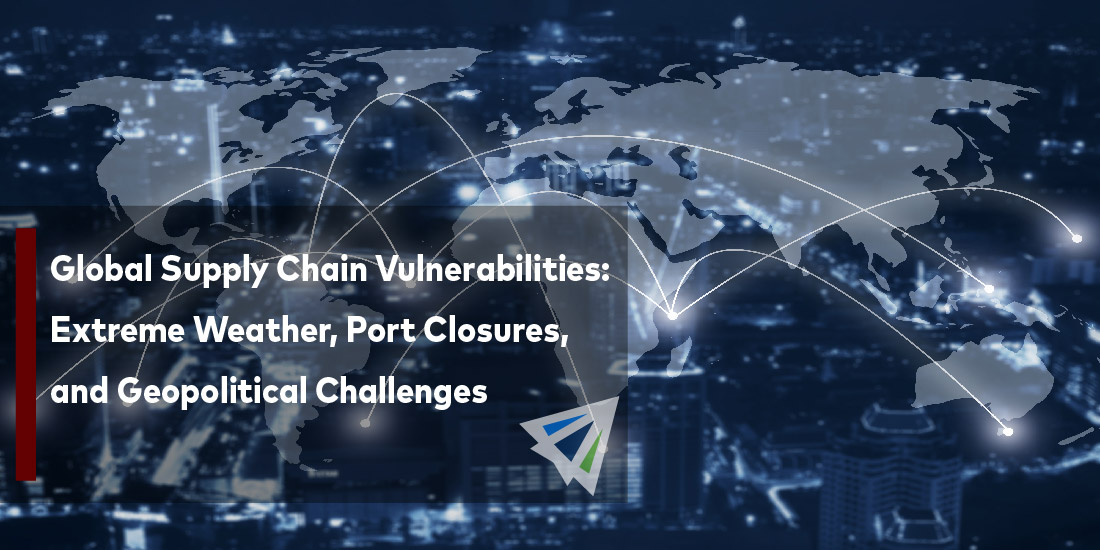Regardless of how long you’ve been in the supply chain and logistics industry, it’s quite likely that you’ve had an experience when something did not go as planned.
The point of this blog is to discuss how the global supply chain can experience vulnerabilities when faced with extreme weather, geopolitical challenges, temporary port closures and others.
Choke Points in Shipping
Extreme Weather
No one can control the weather, and while meteorologists can provide helpful forecasts those forecasts are not a 100% guarantee of what the weather will be like. Earlier this year, an annual outlook report of the top supply chain risks in 2024 by Everstream Analytics had extreme weather as their top risk supply chains could face this year.
The Panama Canal is a great example of how significant drought can impact the supply chain. A large amount of U.S. container traffic travels through the Canal every year and is a critical trade link for U.S. shippers that use the East and Gulf Coast ports. The Panama Canal has increased the number of daily transits to 27, while still down from the typical 36-40 daily transits, this is welcomed news for all those impacted.
On the other hand, flooding can also create challenges. Flooding can cause road closures throughout state highways and interstates, thus impacting travel times.
Additionally, last year prolonged wildfires in Canada caused 1-2 day delays for some deliveries in Chicago and New York. You might remember those eerie images of wildfire smoke lingering in parts of the U.S.
Regardless of what the extreme weather condition may be, it can still play a role in disrupting the supply chain. That’s why paying attention to weather conditions, alerts and forecasts, can help you navigate these challenges.
Geopolitical Challenges
Whether you’re in the industry or not, you’re probably aware of the current issues out in the Red Sea, as well as the geopolitical challenges over in Ukraine and Russia.
As we’ve seen with the Red Sea, the transits through the Suez Canal have been significantly impacted due to vessels being targeted as they traveled through the Canal. This has caused vessels to divert from the Suez Canal and go around the Cape of Good Hope. This has added extra mileage to the vessels journey. Several ocean carriers have stated they have no plans to resume Suez Canal transits until the risk level in the area is not elevated.
We also have a U.S. presidential election set to occur on November 5th this year. Which, depending on the candidate who wins, potentially could create some policy changes. Typically, each candidate in the presidential election has different views on trade agreements, tariffs and foreign relations. These all play a role and can impact the cost and flow of goods imported and exported from the U.S. Additionally, the need for infrastructure improvements usually is on the radar for each candidate but the need regarding how much funding should be allocated, as well as what specific projects occur, can vary between candidates.
It’s difficult to predict what impacts this upcoming presidential election will have on the supply chain/logistics realm, let alone the exact extent of these effects. However, it’s still important to be aware of the different outcomes and potential policy changes and how to mitigate potential impacts.
Temporary Port Closures
The most notable and recent port closure is the Port of Baltimore, which is closed indefinitely due to collapsing after a cargo ship crashed into the bridge. So far we have noticed ocean freight container rates on this to be steady and stable.
While there obviously has been impacts of this port closure, including increased travel times, things are still moving. However, something to keep in mind is the labor negotiations out on the USEC/USGC, which we feel could have more of an impact, should an agreement not be reached when the contract expires on September 31st, 2024. There is some concern that a strike could occur if that agreement is not reached.
Last year at ports in along the coast in Canada, there was a 13-day strike from July 1st to July 13th due to dockworkers failing to reach a new work contract with the BCMEA, who represents the companies involved. This strike created disruptions and bottlenecks in the supply chain and took some time for things to go back to normal.
An interesting news note to share regarding temporary port closures, six days ago, Denmark shut down their main lane in/out of the Baltic due to a mandatory test during a naval exercise where one of their missiles failed and until the booster was disable, there was a risk that the missile could launch and fly several kilometers away. That shipping lane reopened after several hours of being closed. This is worth sharing to note how unplanned things can happen without any notice or expectation of happening.
Looking Ahead
If the pandemic taught us anything, it’s the importance of having contingency plans. As well as knowing that the supply chain has vulnerabilities and how having an effective and efficient plan is important in case something does go awry. The biggest things we stress to our customers is to be aware, stay proactive and diligent, and have contingency plans in place for when things may not go as planned.
Should you have any questions regarding this, please reach out to our team today. We solve issues through mutual expectations, effective communication, and visibility tailored to your needs.
Additionally, we have our weekly market updates that can provide you with relevant freight news, updates, developments across the industry, and more.
